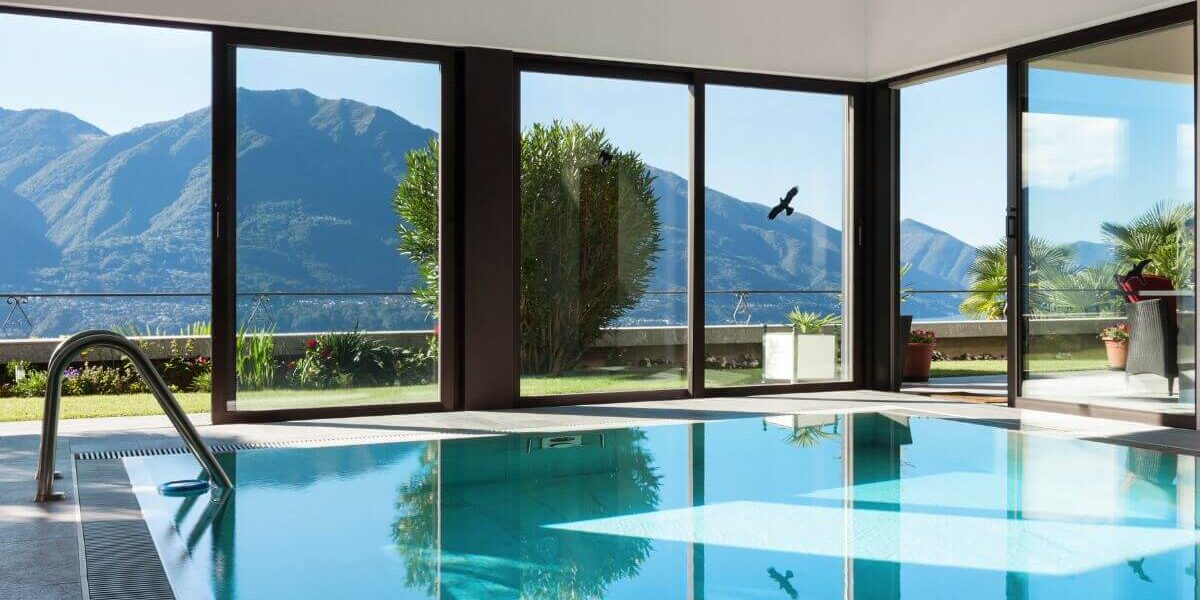You may be thinking of adding a residential indoor swimming pool to your home as a great way to beat the summer heat. Indoor pools are not exactly as maintenance-free as most people think. You still need to maintain them even if no leaves and twigs are blowing in them. Keeping humidity levels controlled and shocking your pool are a few of the needed tasks for your indoor pool to stay refreshing and clean.
Shocking Your Pools
Oxidation treatments are often called pool shocking or super-chlorinating to get rid of the waste that can’t be filtered. This removes body oil, grease, powders, perfumes, and nitrogen from the water which are not filtered through the regular pool filtering process. The biggest difference between shocking an outdoor pool and an indoor pool is that when you oxidate your indoor swimming pool, you need to provide a lot of ventilation. If there isn’t enough ventilation, the waste particles will just fall back into the water and you won’t have accomplished anything. How often you need to do this process depends on the chlorine levels that you have present in your pool. When your free chlorine levels drop below the total chlorine levels, it’s a sign that you need to shock it again
Winter Maintenance
With an outdoor pools, most people close them down in the winter and drain the water out, so they have no maintenance until they are ready to use it again in the spring. With an indoor pool, they aren’t usually drained in the winter and you still need to shock it when necessary. You may not use the swimming pool as much in the winter, but in a controlled environment inside of your home, you will likely still use it. Remember to add a lot of ventilation and move fresh air into the room while you shock it.
This can be done with a large shop fan in the doorway. Then wait until the chlorine levels drop before you go for a swim.
Vacuuming Your Pool
Your swimming pool filtration system is a very hard-working item because they generally run about eight to 12 hours each day. It’s important to keep your pool as clean as possible to make the filter system’s job easier. You should vacuum the interior of your pools thoroughly at least once a week. If you don’t use it much, you can get away with simply brushing the floor and walls each week to break up algae and mold and lighten the load on your filter.
Maintaining The Filter
You should clean your indoor swimming pool filter out about every three months. Use a filter cleaner from a swimming pool supply store on it and spray it down thoroughly with high pressure through a nozzle from your garden hose. Merely spraying it down with water and not enlisting the help of a filter cleaner will return some of the debris back to your pool, making it harder for your filter to work correctly. When you clean the filter, also examine the hoses and fans to make sure that they are operating properly, and don’t forget to flush the entire system to remove all excess chemicals.
Pool Cover Maintenance
Solar swimming pools blanket and automatic pools cover should be cleaned about twice a year. Use a chemical cleaner and then rinse the cover to remove all the dirt and grime from them. Even if you aren’t using the swimming pool very often, you still need to perform this cleaning procedure because substances can get trapped under the cover or blanket over long periods of time.
Testing The Water
You always need to keep your water chemistry at the correct levels for your indoor pool to run at its best. You should test the pH levels and make sure they are all balanced and the levels of free chlorine and total chlorine so you will know when you need to shock your pool. If you are new to pH testing, a sure sign that the chemical levels need attention is a foul odor. You simply shock the water with chlorine and add chemicals until your pH level is back to normal to correct this.
Humidity Levels
The biggest issue with indoor swimming pools is improper ventilation and windows that are not insulated well. Substandard windows can allow more humidity into the area of the pool and increase the growth of algae and mold. High humidity levels can also weaken any wood in the indoor pool area and cause it to need replacing prematurely because of rot. You should make sure you have good ventilation and a dehumidifier system in the pool area as well.
Conclusion
At Aqua Guard 5000, we have been installing both indoor and outdoor swimming pools for over 30 years. We can help you with all of your needs for residential pools. You can shop pool paint, restoration, and repair products from us and our knowledgeable employees are always delighted to meet you and help you solve any issues or answer any questions you may have about your swimming pool. Contact us today to learn more about indoor residential swimming pools.







